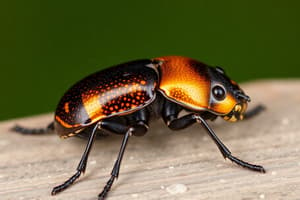Podcast
Questions and Answers
What does Insect Taxonomy refer to?
What does Insect Taxonomy refer to?
- The classification of organisms in an ordered system (correct)
- The habitat of insects
- The study of insect behavior
- The anatomy of insects
What is the Kingdom classification based on?
What is the Kingdom classification based on?
Heterotroph, multicellular, eukaryote
What are the characteristics of the Phylum classification?
What are the characteristics of the Phylum classification?
Invertebrate, exoskeleton, segmented body, jointed legs
What defines the Class classification of insects?
What defines the Class classification of insects?
What are the stages of Simple Metamorphosis?
What are the stages of Simple Metamorphosis?
What are the stages of Complete Metamorphosis?
What are the stages of Complete Metamorphosis?
Name the body parts of an insect.
Name the body parts of an insect.
What features does the head of an insect have?
What features does the head of an insect have?
How is the thorax divided?
How is the thorax divided?
What does the abdomen contain?
What does the abdomen contain?
Give an example of Simple Metamorphosis.
Give an example of Simple Metamorphosis.
Give an example of Complete Metamorphosis.
Give an example of Complete Metamorphosis.
What are the characteristics of Arthropods?
What are the characteristics of Arthropods?
List the characteristics of insects.
List the characteristics of insects.
What is the mnemonic for Taxonomy Order/Tricks?
What is the mnemonic for Taxonomy Order/Tricks?
What defines a Eukaryote?
What defines a Eukaryote?
What defines a Prokaryote?
What defines a Prokaryote?
Multicellular organisms consist of a single cell.
Multicellular organisms consist of a single cell.
Unicellular organisms consist of many cells.
Unicellular organisms consist of many cells.
What is the nucleus?
What is the nucleus?
Flashcards are hidden until you start studying
Study Notes
Insect Taxonomy
- Classification system that organizes organisms to reveal natural relationships.
Kingdom
- Characteristics: heterotrophic, multicellular, and eukaryotic organisms.
Phylum
- Invertebrates with key features: an exoskeleton, segmented bodies, and jointed legs.
Class
- Distinctive traits: six legs, wings, two antennae, and three body segments (head, thorax, abdomen).
Simple Metamorphosis
- Consists of three life stages: fertilized egg, nymph, and adult.
Complete Metamorphosis
- Comprises four stages: fertilized egg, larval (worm-like) stage, pupal (transformative) stage, and adult.
Body Parts of Insects
- Main structures include head, thorax, and abdomen.
Head
- Features: simple and compound eyes, two antennae for sound response, and various mouthparts.
Thorax
- Structure: divided into three segments (prothorax, mesothorax, metathorax) and hosts legs and wings.
Abdomen
- Consists of ten segments, has openings for respiration allowing oxygen circulation.
Examples of Simple Metamorphosis
- Organisms such as crickets, bugs, and grasshoppers.
Examples of Complete Metamorphosis
- Organisms include ants, flies, butterflies, beetles, and mosquitoes.
Arthropods
- Multicellular consumers that lack chlorophyll, characterized by exoskeletons, jointed legs, and segmented bodies.
- Divided into five classes: Centipedes, Millipedes, Crustaceans, Insects, and Arachnids.
Characteristics of Insects
- Notable features include jointed legs, segmented bodies, exoskeletons, three pairs of legs, two antennae, and the potential for wings.
Taxonomy Order Mnemonic
- Utilize the phrase: "King-Kingdom, Phillip-Phylum, Came-Class, On-Order, Friday-Family, Gave-Genus, Speech-Species" to remember the classification hierarchy.
Cell Types
- Eukaryote: Organisms with cells that contain a nucleus.
- Prokaryote: Organisms whose cells lack a nucleus.
Multicellular vs. Unicellular
- Multicellular: Composed of many cells.
- Unicellular: Composed of a single cell.
Nucleus
- A cell's dense region housing nucleic acids.
Studying That Suits You
Use AI to generate personalized quizzes and flashcards to suit your learning preferences.




